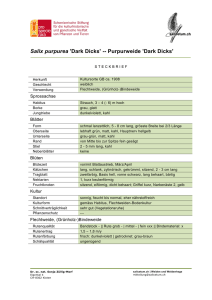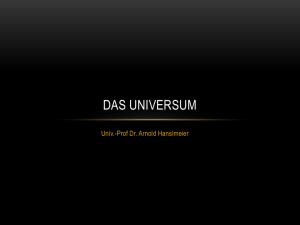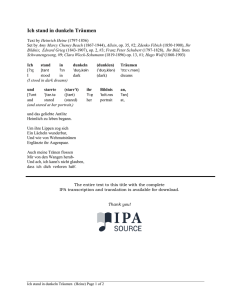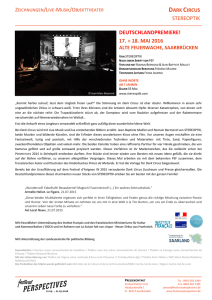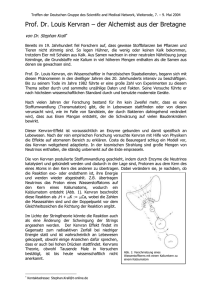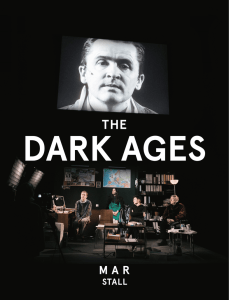T 106: Suche nach Dunkler Materie 4 - DPG
Werbung
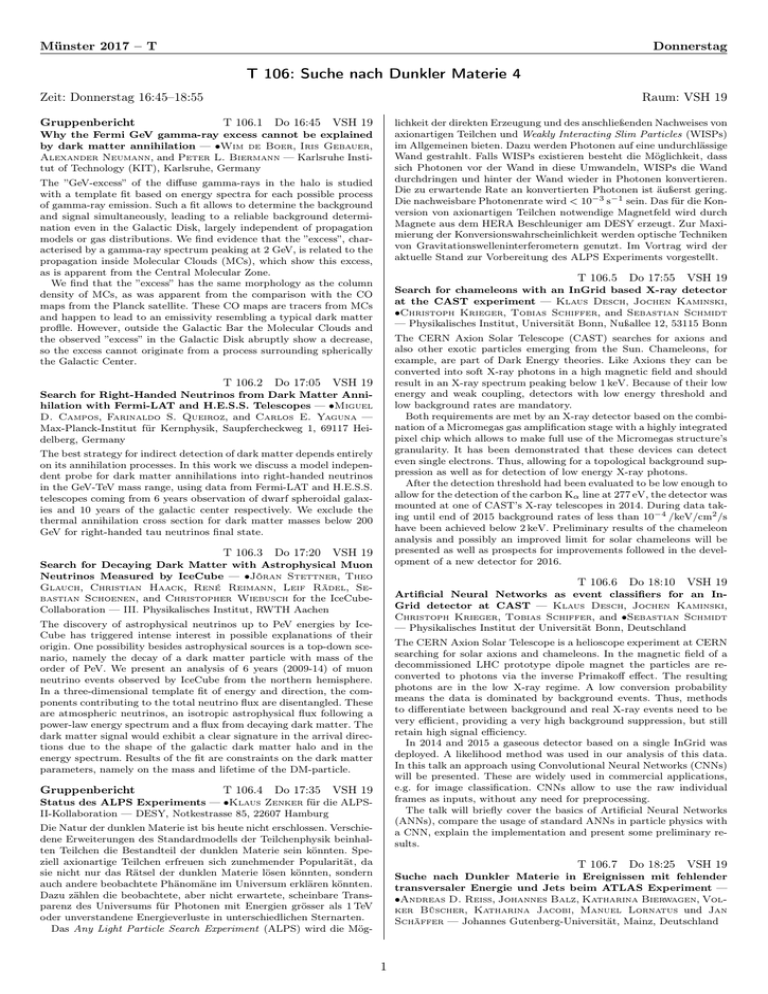
Münster 2017 – T Donnerstag T 106: Suche nach Dunkler Materie 4 Zeit: Donnerstag 16:45–18:55 Gruppenbericht Raum: VSH 19 T 106.1 Do 16:45 VSH 19 lichkeit der direkten Erzeugung und des anschließenden Nachweises von axionartigen Teilchen und Weakly Interacting Slim Particles (WISPs) im Allgemeinen bieten. Dazu werden Photonen auf eine undurchlässige Wand gestrahlt. Falls WISPs existieren besteht die Möglichkeit, dass sich Photonen vor der Wand in diese Umwandeln, WISPs die Wand durchdringen und hinter der Wand wieder in Photonen konvertieren. Die zu erwartende Rate an konvertierten Photonen ist äußerst gering. Die nachweisbare Photonenrate wird < 10−3 s−1 sein. Das für die Konversion von axionartigen Teilchen notwendige Magnetfeld wird durch Magnete aus dem HERA Beschleuniger am DESY erzeugt. Zur Maximierung der Konversionswahrscheinlichkeit werden optische Techniken von Gravitationswelleninterferometern genutzt. Im Vortrag wird der aktuelle Stand zur Vorbereitung des ALPS Experiments vorgestellt. Why the Fermi GeV gamma-ray excess cannot be explained by dark matter annihilation — ∙Wim de Boer, Iris Gebauer, Alexander Neumann, and Peter L. Biermann — Karlsruhe Institut of Technology (KIT), Karlsruhe, Germany The ”GeV-excess” of the diffuse gamma-rays in the halo is studied with a template fit based on energy spectra for each possible process of gamma-ray emission. Such a fit allows to determine the background and signal simultaneously, leading to a reliable background determination even in the Galactic Disk, largely independent of propagation models or gas distributions. We find evidence that the ”excess”, characterised by a gamma-ray spectrum peaking at 2 GeV, is related to the propagation inside Molecular Clouds (MCs), which show this excess, as is apparent from the Central Molecular Zone. We find that the ”excess” has the same morphology as the column density of MCs, as was apparent from the comparison with the CO maps from the Planck satellite. These CO maps are tracers from MCs and happen to lead to an emissivity resembling a typical dark matter proflle. However, outside the Galactic Bar the Molecular Clouds and the observed ”excess” in the Galactic Disk abruptly show a decrease, so the excess cannot originate from a process surrounding spherically the Galactic Center. T 106.2 Do 17:05 T 106.5 VSH 19 The best strategy for indirect detection of dark matter depends entirely on its annihilation processes. In this work we discuss a model independent probe for dark matter annihilations into right-handed neutrinos in the GeV-TeV mass range, using data from Fermi-LAT and H.E.S.S. telescopes coming from 6 years observation of dwarf spheroidal galaxies and 10 years of the galactic center respectively. We exclude the thermal annihilation cross section for dark matter masses below 200 GeV for right-handed tau neutrinos final state. Do 17:20 VSH 19 Search for Decaying Dark Matter with Astrophysical Muon Neutrinos Measured by IceCube — ∙Jöran Stettner, Theo Glauch, Christian Haack, René Reimann, Leif Rädel, Sebastian Schoenen, and Christopher Wiebusch for the IceCubeCollaboration — III. Physikalisches Institut, RWTH Aachen T 106.6 T 106.4 Do 17:35 Do 18:10 VSH 19 Artificial Neural Networks as event classifiers for an InGrid detector at CAST — Klaus Desch, Jochen Kaminski, Christoph Krieger, Tobias Schiffer, and ∙Sebastian Schmidt — Physikalisches Institut der Universität Bonn, Deutschland The discovery of astrophysical neutrinos up to PeV energies by IceCube has triggered intense interest in possible explanations of their origin. One possibility besides astrophysical sources is a top-down scenario, namely the decay of a dark matter particle with mass of the order of PeV. We present an analysis of 6 years (2009-14) of muon neutrino events observed by IceCube from the northern hemisphere. In a three-dimensional template fit of energy and direction, the components contributing to the total neutrino flux are disentangled. These are atmospheric neutrinos, an isotropic astrophysical flux following a power-law energy spectrum and a flux from decaying dark matter. The dark matter signal would exhibit a clear signature in the arrival directions due to the shape of the galactic dark matter halo and in the energy spectrum. Results of the fit are constraints on the dark matter parameters, namely on the mass and lifetime of the DM-particle. Gruppenbericht VSH 19 The CERN Axion Solar Telescope (CAST) searches for axions and also other exotic particles emerging from the Sun. Chameleons, for example, are part of Dark Energy theories. Like Axions they can be converted into soft X-ray photons in a high magnetic field and should result in an X-ray spectrum peaking below 1 keV. Because of their low energy and weak coupling, detectors with low energy threshold and low background rates are mandatory. Both requirements are met by an X-ray detector based on the combination of a Micromegas gas amplification stage with a highly integrated pixel chip which allows to make full use of the Micromegas structure’s granularity. It has been demonstrated that these devices can detect even single electrons. Thus, allowing for a topological background suppression as well as for detection of low energy X-ray photons. After the detection threshold had been evaluated to be low enough to allow for the detection of the carbon K𝛼 line at 277 eV, the detector was mounted at one of CAST’s X-ray telescopes in 2014. During data taking until end of 2015 background rates of less than 10−4 /keV/cm2 /s have been achieved below 2 keV. Preliminary results of the chameleon analysis and possibly an improved limit for solar chameleons will be presented as well as prospects for improvements followed in the development of a new detector for 2016. Search for Right-Handed Neutrinos from Dark Matter Annihilation with Fermi-LAT and H.E.S.S. Telescopes — ∙Miguel D. Campos, Farinaldo S. Queiroz, and Carlos E. Yaguna — Max-Planck-Institut für Kernphysik, Saupfercheckweg 1, 69117 Heidelberg, Germany T 106.3 Do 17:55 Search for chameleons with an InGrid based X-ray detector at the CAST experiment — Klaus Desch, Jochen Kaminski, ∙Christoph Krieger, Tobias Schiffer, and Sebastian Schmidt — Physikalisches Institut, Universität Bonn, Nußallee 12, 53115 Bonn The CERN Axion Solar Telescope is a helioscope experiment at CERN searching for solar axions and chameleons. In the magnetic field of a decommissioned LHC prototype dipole magnet the particles are reconverted to photons via the inverse Primakoff effect. The resulting photons are in the low X-ray regime. A low conversion probability means the data is dominated by background events. Thus, methods to differentiate between background and real X-ray events need to be very efficient, providing a very high background suppression, but still retain high signal efficiency. In 2014 and 2015 a gaseous detector based on a single InGrid was deployed. A likelihood method was used in our analysis of this data. In this talk an approach using Convolutional Neural Networks (CNNs) will be presented. These are widely used in commercial applications, e.g. for image classification. CNNs allow to use the raw individual frames as inputs, without any need for preprocessing. The talk will briefly cover the basics of Artificial Neural Networks (ANNs), compare the usage of standard ANNs in particle physics with a CNN, explain the implementation and present some preliminary results. VSH 19 Status des ALPS Experiments — ∙Klaus Zenker für die ALPSII-Kollaboration — DESY, Notkestrasse 85, 22607 Hamburg Die Natur der dunklen Materie ist bis heute nicht erschlossen. Verschiedene Erweiterungen des Standardmodells der Teilchenphysik beinhalten Teilchen die Bestandteil der dunklen Materie sein könnten. Speziell axionartige Teilchen erfreuen sich zunehmender Popularität, da sie nicht nur das Rätsel der dunklen Materie lösen könnten, sondern auch andere beobachtete Phänomäne im Universum erklären könnten. Dazu zählen die beobachtete, aber nicht erwartete, scheinbare Transparenz des Universums für Photonen mit Energien grösser als 1 TeV oder unverstandene Energieverluste in unterschiedlichen Sternarten. Das Any Light Particle Search Experiment (ALPS) wird die Mög- T 106.7 Do 18:25 VSH 19 Suche nach Dunkler Materie in Ereignissen mit fehlender transversaler Energie und Jets beim ATLAS Experiment — ∙Andreas D. Reiß, Johannes Balz, Katharina Bierwagen, Volker Büscher, Katharina Jacobi, Manuel Lornatus und Jan Schäffer — Johannes Gutenberg-Universität, Mainz, Deutschland 1 Münster 2017 – T Donnerstag Dunkle Materie konnte bisher nur indirekt durch die Auswirkungen der Gravitation im Kosmos beobachtet werden. Durch die Datennahme mit dem Large Hadron Collider in 2015 und 2016 mit einer Schwerpunktsenergie von 13 TeV wurden direkte Suchen nach Dunkler Materie in Proton-Proton-Kollisionen unter Abstrahlung von Quarks oder Gluonen im Anfangszustand ermöglicht. Die hier vorgestellte Analyse befasst sich mit der Produktion von Dunkler Materie unter Beobachtung von einem oder mehreren Jets und fehlender transversaler Energie beim ATLAS-Experiment. Bislang wurde hierbei ausschließlich die fehlende transversaler Energie als Diskriminante zwischen Signal und Untergrund verwendet. Weitere topologischen Variablen werden studiert indem Formunterschiede in Multijetereignissen ausgenutzt werden, welche aufgrund von unterschiedlichen Produktionsmechanismen von Signal und Untergrund existieren. Diese konnten verwendet werden, um die Sensitivität der Analyse zu verbessern. T 106.8 Do 18:40 Hamburg, Institut für Experimentalphysik, Luruper Chaussee 149, 22761 Hamburg The International √ Linear Collider (ILC) is a planned electron-positron collider with 𝑠 tunable from 250 to 500 GeV, with a possible upgrade to 1 TeV. Besides precision measurements of the Higgs boson its physics goals comprise searches for physics beyond the Standard Model, e.g. searches for Dark Matter. This collider search assumes the production of WIMPs in pairs. They are not visible in the detector but the energy carried away can be observed via an additional ("tag") particle. Photon emission from the initial state leads to the almost model independent signature: 𝑒+ 𝑒− → 𝜒𝜒𝛾. As this analysis tests couplings between WIMPs and leptons it is complementary to analogues searches at the LHC and direct detection. A precise study is facilitated by the clean environment of lepton colliders with small systematics of electroweak backgrounds. While the conceptual feasibility and the sensitivity reach of the ILC have been shown in the past, this talk focusses on the treatment of the main reducible Standard Model background: Radiative Bhabha scattering 𝑒+ 𝑒− → 𝑒+ 𝑒− 𝛾 mimics the signal if the leptons are undetected. Hence the best possible hermeticity of the detector, especially in the forward region, is one of the key requirements on the detector design. VSH 19 WIMP search at the International Linear Collider — ∙Moritz Habermehl1,2 and Jenny List1 — 1 Deutsches ElektronenSynchrotron DESY, Notkestrasse 85, 22607 Hamburg — 2 Universität 2


